Abstract
This paper describes how a course on TEFL methodologies presented to the students of DELTC was transformed into a blended learning experience by use of an online portfolio hosted by Mahara.org. This e-portfolio allowed the course teacher to introduce new ICT-educational aspects to the participants and at the same time provided the opportunity to evaluate their experience during their usage of the website according to Salmon’s model in blended learning. Based on the experiences from the course, this paper will discuss the students’ opinions relating to their experiences upon using Mahara e-portfolio and the development of their language and communication skills by the end of the course. The paper will try to attest that online tools such as wikis have actually been a success as they are not that costly. Since these portfolios are never limited by either time or any other factor, comments from teachers to students are highly enhanced. This paper sums up with overall merits of electronic portfolios that are presented in the regular portfolios.
Introduction
TEFL and online technologies have been consolidated in many research and educational projects for many years since the evolution of web 2.0 tools. With the increased use of online learning channels, teachers and students can Learn and teach from the leisure and ease of their homes, can talk to each other at any time. As a matter of fact, online learning tools such as blogs, wikis, and other platforms of e-portfolios and social network are not expensive at all and do not require complicated IT knowledge. With all these introductory features, online learning tools are as effective as normal education and typical classroom activities.
Although people might think that having more “high tech” equipment and tools would help facilitate more effective distance learning, evidence from research suggests that it is not the technology itself but rather its proper use that would make or break a distance-learning program. Sometimes, very simple technologies, combined with well-designed instruction, are as – and sometimes more— effective than more complex and expensive technologies (Batson, 2002). The teacher’s responsibilities such as choosing the proper online tool, designing the online content with clear objectives and assessment rubrics, motivating students and monitoring all activities have critical impacts on the effectiveness and success of the online experience. As the teacher employs his/her best knowledge of technology and makes goals clear and organized, the teaching/learning processes will go smoothly and effectively.
With the advent of technology, electronic portfolios are introduced. Electronic portfolios (e-portfolios) refer to the online virtual spaces where students upload artifacts to document and showcase their learning processes (Huang & Hung, 2010).
Barett asserts in his book that e-portfolio incorporates the use of online technologies that permit the initiators of the portfolio to amass and systemize artifacts in different formats (Barett, 2000). Heath (2002) proposes, it is easier to maintain, edit and update than its paper counterpart electronically speaking. With electronic portfolios, students’ work can be collected as well as stored and managed electronically, taking very little or no physical space. Furthermore, since internet based electronic portfolios are not constrained by time, they also enhance peer and teacher feedback, two major components of portfolio assessment. Therefore, electronic portfolios offer all of the advantages of regular portfolios such as the opportunity to self assess the writing process, as well as other advantages regular portfolios lack (Pullman, 2002).
Research Questions
The research questions that guided the investigation in this study go as follows:
- What is the students’ opinion toward using the online portfolio as an easily accessible and motivating learning environment?
- What is the students’ opinion toward using the online portfolio as a socializing learning environment?
- What is the students’ opinion toward using the online portfolio as a source of information and knowledge exchange?
- What is the students’ opinion toward using the online portfolio as a knowledge developing tool?
- What is the students’ opinion toward using the online portfolio as a tool that fosters students’ reflective thinking and assessment?
Aim and significance of the research
This research paper supplements and perpetuates the pool of current literature by presenting a theoretical model that can be adopted to examine the student teachers opinions on using Mahara e-portfolios. The results from this study will be used to compare the traditional teaching and learning experiences and outcomes to those of blended learning using online tools such as e-portfolios, present the changing perspectives of students teachers on using online learning tools as means to enhance their educational awareness of teaching methodologies, and activate the need for more online learning consolidation for both teachers and students.
The research also provides insights for the course developers and serves as background material for all e-portfolio trainers in the growing e-portfolio community and beyond. Therefore, the research:
- Describes the opinions and experiences of the pre-service teachers which identify their needs for specific online learning support. The outcome is an over view of success factors for implementing this new instrument in daily educational practice whether as pre or full time teachers.
- Introduces the concept, purposes, and functions of e-portfolio in general and online versions in specific, describes its potentials for improving learners’ educational engagement and vocational planning as teachers of EFL.
- Provides an overview of some Open Source initiatives and projects around the world, especially for those new to the (electronic) e-portfolio concept.
- Proposes recommendations and qualifications needed by students and teachers for using online portfolios.
Literature review
According to an invention that was performed in 1990, electronic portfolios come about at the junction of three tendencies. The first trend is that the work of the scholar is presently in electronic form. The second tendency is that the websites are offered in all parts of the globe. This allows scholars to control their hefty work. The third trend is that the lively web that is driven by databases has turned out to be a rule for the developers of the web. “We have reached a critical mass along with electronic saturation on campus; leading to the emergence of new norms. Arising out of this critical mass is a vision of how higher education can benefit, which is with the e-Portfolio” (Heath, 2002).
Today’s college students have grown up in the age of the Information Superhighway. Incoming freshmen college students are now expected to have at least a basic understanding of computer technology: word processing and data entry, use of e-mail, and presentation skills in PowerPoint, for example. The pace of technological change is ever increasing and new technologies are constantly appearing in the academic environment—online discussion forums, distance education, video-conferencing, WebCT, and now, e-portfolios (Campbell & Schmidt, 2005).
E-portfolios around the world
Around the world and throughout the history of e-portfolios, there are many leading projects and initiatives that played a fundamental role in the way education is organized and in the way teaching and learning operate. Many of these academic e-portfolios are driving force of educational, personal, and social change. Heath (2002) presents a number of leading consortiums such as ePortconsortium. The Electronic Portfolio Consortium (ePortConsortium) is a collaboration of higher education and information technology institutions working to define, design, and develop software for electronic portfolio environments and systems (Heath, 2002).
From a social shaping of technology perspective, the ePortConsortium represents collaboration at the highest level. As new interoperability and transportability standards are established, implementation of e-portfolios by universities will be much easier. One of the goals of the ePortConsortium is to develop standards that will allow e portfolio systems created by commercial software companies and those built by educational institutions to be compatible.
The OSPI -Open Source Portfolio Initiative- illustrated by Dickinson is a society of persons and corporations working together on the enhancement of the chief non proprietary, OSPI program obtainable (Dickinson, 1987). It was formed in January 2003 by the University of Minnesota, University of Delaware, and the r-smart group in order to open the University of Minnesota’s e-portfolio program to diverse input, rapid development, and widespread use (2004).
The National Learning Infrastructure Initiative (NLII) was formed in 1994 under the umbrella of EDUCAUSE, a non-profit organization whose mission is “to advance higher education by promoting the intelligent use of information technology” (Weigel, 2002). Recognizing the growing trend of electronic portfolio development, e-portfolios were featured as a key theme of the NLII’s annual meeting in 2003.
As part of the e-Learning Collaboration Development Fund, Massey University, the Auckland University of Technology, the Open Polytechnic of New Zealand and Victoria University of Wellington, Mahara e-portfolio application for the New Zealand tertiary sector has been developed. The aim was to develop a new open source e-portfolio application and to provide guidelines for its effective use based on the experience of a number of implementation case studies (Sherry & Bartlett, 2005). Mahara can be described as an example of a well known e-portfolio. It can also be said as a weblog that aims at facilitating social interaction among scholars.
Mahara therefore helps in the development of an online students’ community. Mahara was meant for the provision of tools that will enable its clients to create an individualized and specialized learning development. Ellsworth (2002) denoted the following:
The name Mahara reflects the intention to create a user centered lifelong learning and development application, as well as the belief that ICT must be used to promote more collaborative, interactive, media rich and personalized learning. (p.56)
What makes Mahara different from other e-portfolios is that learners control which items and what information other users see.
For the purpose of facilitating the access control, the artifacts that one wishes to depict to other clients ought to be packaged and consigned in a specific place. ‘View’ is the term used to refer to the assemblage of preferred artifacts in Mahara. An individual in Mahara is allowed to have his/her desired number of views. Clients who are allowed to access your views may be added as either an individual or a community (McIsaac & Gunawardena, 1996).
Since the e-portfolio is very much an evolution of the traditional portfolio, many of the benefits can be attributed to the electronic version such as: students’ motivation, socialization, knowledge exchange, knowledge construction, and students’ self assessment.
E-portfolios as an easily accessible and motivating learning environment
It is argued that we all have different styles of learning and approach learning in different ways. Notwithstanding the problems of the theoretical debate on learning styles, it would appear likely that learners will have preferences for different pedagogical approaches and learning strategies, in particular learning con texts. E-portfolios can allow learners to configure and develop the learning environment to suit and enable their own approach to learning. This can have a relevant effect on student motivation (Chen, 2005).
“Students who have the freedom to choose different strategies and approaches may become more engaged in the learning process, and these students will be more likely to approach other problems with an open mind. In addition, students who are involved in creating the project assignment or the project checklist gain valuable experience in setting their own goals and standards of excellence. This gives students a sense of owner ship and control over their own learning” (Sherry & Bartlett, 2005).
It is very significant for learners to recognize the good instances of e-portfolios, acknowledge their gains, and recognize the ways they will use to enable other students grow as learners and eventually get employment. The learners are urged to focus on portfolios the moment they recognize what they will gain from the experience. It is very significant to acknowledge the ways through which the e-portfolio will be appraised, in spite of the fact that most people see this as a normal task. It is also important for scholars to concentrate on convening the appraisal criteria as well as the demerit of thinking decisively regarding their educational journey. As O’Malley & Valdes argue, “clear rubrics and scaffolding for students on how to reflect so that they internalize the benefits of reflective practice are clearly needed if this approach to learning is going to be embraced by most learners” (O’Malley & Valdes, 1996, p. 13).
Mentioning adaptability and accessibility, it is relatively easy for material to be added, deleted, adapted or rearranged compared with that in a traditional portfolio, so it is much more likely to be kept up to date than its paper counterpart. The material does not have to be arranged or read in a linear or hierarchical structure (Chamot & O’Malley, 1994). If the e-portfolio is hosted on a web site, prospective viewers can be granted access by being given the site address and any necessary access permissions. If necessary it can also be copied relatively easily on to a CD or DVD then distributed. This also opens the way for more immediate feedback from a wider range of sources (Avraamidou & Zembal-Saul, 2004). The e-portfolio tool may also allow different arrangements of the material to be seen depending on the ‘access’ given to the audience (Dickinson, 1987).
E-portfolio as a socializing learning environment
Discussed by Barrett, e-Portfolios offer an opportunity for allowing learners to use computers as they do in their social life, to create, to share and to network. They potentially represent a move to overcome the somewhat alarming gap between educational software and the applications used everyday both by young people and in the workplace. Why only ‘potentially’? The ability to create, share and network depends both on the design of e-Portfolio applications and the approaches to the pedagogic use of the e-Portfolio as well as the integration of the e-Portfolio in the wider context of curriculum provision.
There is an issue as to how much learning takes place through participation and engagement in social networking sites. However, the failure of the education providers to engage with this activity risks schools and other educational institutions becoming irrelevant to the way in which young people interact and exchange ideas (2000). A study of the use of ICT for learning in Small and Medium Enterprises found that whilst there was little evidence of formal e-learning computers were being widely used for informal learning through amongst other things participation in networks and distributed communities of practice.
Furthermore, there was some evidence that older workers were more likely to participate in such activities (probably because of more autonomy in how they undertook their work). It was also noteworthy that in addition to being motivated by the need to solve work based problems, much of the participation was driven by personal interest. E-portfolios offer an opportunity for allowing learners to use computers as they do in their social life, to create, to share and to network. They potentially represent a move to overcome the somewhat alarming gap between educational software and the applications used everyday both by young people and in the workplace
E-portfolio as a source of information and knowledge exchange
An e-portfolio allows a relatively large amount of material to be stored and shared in a cost effective way, either physically on a CD or DVD, or online (Harnell-Young & Morriss, 2007). Since they are electronic, e-portfolios can contain not just text data but material such as audio files, video files and slide presentations. Much of this is in an electronic format to start with which makes it more convenient to keep it this way rather than convert it into paper format (Heath, 2002).
E-portfolio as a knowledge developing tool
There is some evidence that more focused pedagogic development is possible through an e-Portfolio related to particular curriculum areas such as the innovatory use of blogs within English language and creative writing courses. E-Portfolios have been used as a tool for motivation with socially disadvantaged learners undertaking vocational project work (O’Malley & Valdes, 1996). When discussing knowledge development, there is a strong relation between constructing knowledge and content of the e-portfolio. there is the issue – already discussed in this paper – of whether e-portfolio content should be restricted to that related to formal course objectives and outcomes or whether learners should be encouraged to include wider content drawn from both formal and informal learning – or indeed the fuzzy interface between the two – and from wider contexts for learning including personal and social activities and from work.
Of course, if e-Portfolio provision is extended to those not enrolled in formal education programs or is used for Continuing Professional Development, it is likely that work and personal learning will comprise the bulk of an e-Portfolio. The issue of selecting what to show in an e-Portfolio can be largely overcome if the system provides tools to select material for specific presentation. Not only does this facilitate different presentations for different purposes – just as when submitting a CV for a job application or for entry to a course were-purpose or re-present the materials to suit the particular post or course we are applying for – but the process of selection itself is an act of reflection on achievements and learning.
E-portfolio as a tool for self-assessment
It has been argued that self assessment serves as an effective language learning strategy to promote autonomous language learning because it encourages language learners to assess their learning progress and in turn helps them to stay focused on their own learning (Chamot & O’Malley, 1994; Chen, 2005). The proponents of self assessment strategies maintain that participating in self assessment can help learners become skilled judges of their own strengths and weaknesses and establish realistic and attainable goals for themselves, thus developing their self directed language learning ability (Chamot & O’Malley, 1994; Dickinson, 1987).
A widely used instrument for self assessment is the portfolio. Portfolios provide an opportunity for English as a Foreign /Second language (EFL/ESL) learners to monitor their own writing progress and take responsibility for meeting goals. By documenting growth over time through a systematic collection of their work, portfolios enable learners to see possibilities for reflection, redirection, and confirmation of their own learning efforts (O’Malley & Pierce, 1996).
Simply put, when a student reviews a written piece and decides to revise and improve it, the student engages in self assessment. A widely used instrument for practicing self assessment strategies is the portfolio.
Portfolios provide an opportunity for learners to monitor their own progress and take responsibility for meeting goals. Weigel (2002) points out that through the portfolio approach “second language learners are acknowledged as contributors and the multicultural resources that the students bring to assessment situations serve as rich data sources”. She further delineates that port folios designed by second language learners can help capture the full range of the students’ competencies in one or more languages.
Developmental portfolios also enable learners to demonstrate their growth in language proficiency, including oral language and literacy development, academic achievement, attitudinal variation in terms of acculturation and learning and acquisition of learning strategies (Weigel, 2002). Hence, at the heart of portfolio pedagogy is a place for self assessment guided by learners (Wade & Yarbrough, 1996). E-portfolio assessment may offer other benefits such as increasing student reflection (Ellsworth, 2002), revealing information not made known by other assessment methods (Pullman, 2002), making students more active and taking a greater role in assessment and their learning as a whole (Campbell & Schmidt, 2005), giving students more ways to demonstrate their knowledge, and making longitudinal studies possible (Heath, 2002).
In projects and at conferences about e-portfolios, at some point the discussion seems always to turn to the issue of how to facilitate meaningful reflection. In this regards, a study conducted by Chen (2005) identifies a structure of students reflection that includes skills such as forming an opinion; expressing an opinion; articulating an opinion; justifying an opinion; defending an opinion; supporting opinions of other; challenging others’ opinions; questioning others; seeking clarification; representing others opinions; building on others’ opinions; sorting fact from opinion. Each of these processes can be structured and supported within the e-portfolio development process. However, they also require skills on the part of the teacher or facilitator. These might include facilitator skills; active listening skills; feedback skills; intervention skills; and evaluation skills.
Methodology
The method used for this study was qualitative case study. According to Wade & Sclater (2005), a case study is a particularly suitable design if the researcher is interested in process. Therefore, the present study, aiming to explore, understand, and analyze EFL learners’ use of strategies, employed a case study to provide in-depth portraits of two EFL learners’ use of strategies while they were writing in their electronic portfolios.
Participants
The researcher wants to discover, understand, and gain insight; therefore, they must select participants from whom the most can be learned. Hence, data for the current study were collected through the researcher’s connection with a college level EFL teacher in Taiwan, who required students to design electronic portfolios as an assignment for the class. The teacher was then asked to recommend some EFL students who showed interests in participating in the study.
Then, the researcher began to contact the potential participants by email. The two participants were finalized based on their willingness to participate in the study and completeness of their electronic portfolios. Both of them were college EFL learners who were enrolled in an English class at a university in an EFL context.
Implementation
The portfolio project was implemented in an EFL classroom for a semester of 18 weeks. At the beginning of the semester, students learned how to create their own electronic portfolios at a free electronic portfolio website, a readymade webpage that calls for only minimal computer skills. During the semester, the students worked on and uploaded two required 300word essays with drafts, gave peer feedback and revised essays according to teachers’ and peers’ comments. In addition, they were encouraged to upload self chosen entries, such as diary entries and anecdotes. At the end of the semester, students’ portfolios were evaluated and took twenty percent of students’ final grade.
Data collection
The data for the current study were collected through the following tools:
- Questionnaire: Based on the five-step model of Salmon’s, a questionnaire was administered in which participants express their opinions-depending on a 5-scale rating-relating to the effectiveness of their experience in Mahara e-portfolio throughout the course. Based on three major research questions, the researcher crafted the questionnaire and then forwarded it t o a qualified colleague for peer debriefing. Then, the researcher revised the questionnaire in accordance with the comments the colleague provided.
- Students’ participation in the course forum in Mahara.
As student share personal stories and ideas, sharing and exchanging information, students are successfully processing information and become more proactive in their learning, transmit knowledge and then create and generalize innovative ideas. The collected data were analyzed qualitatively and coded into the five categories—the (the 5 stages in the survey).
Findings and Discussion
Estimating reliability and validity of data
To insure the reliability (or internal consistency) and the validity of our data, Cronbach’s alpha is to be conducted on the entire survey instrument (all subscales combined) and on each individual subscale, as follows:
- Reliability Statistics for the overall survey instrument
- Reliability Statistics
- Reliability Statistics for the items of Access and Motivation
- Reliability Statistics
- Reliability Statistics for the items of Online Socialization
- Reliability Statistics
- Reliability Statistics for the items of Information Exchange
- Reliability Statistics
- Reliability Statistics for the items of Knowledge Construction
- Reliability Statistics
- Reliability Statistics for the items of Development
- Reliability Statistics
Summary of reliability and Validity statistics
*Validity is calculated by taking the square root of reliability.
From the summary in the table above we find the following:
- The reliability of the first group items (questions) – relating to the Students’ opinion toward using the online portfolio as an easily accessible and motivating learning environment – is 0.238 or (23.8%)
- The reliability of the first group items (questions) – relating to the Students’ opinion toward using the online portfolio as a socializing learning environment – is 0.536 or (53.6%)
- The reliability of the first group items (questions) – relating to the Students’ opinion toward using the online portfolio as a source of information and knowledge exchange – is 0.302 or (30.2%)
- The reliability of the first group items (questions) – relating to the Students’ opinion toward using the online portfolio as a knowledge developing tool – is 0.444 or (44.4%)
- The reliability of the first group items (questions) – relating to the Students’ opinion toward using the online portfolio as a tool that fosters students’ reflective thinking and assessment – is 0.819 or (81.9%)
- The overall reliability of the survey instrument is 0.843 or (84.3%)
Except for the first group, the results show a relatively high estimated reliability as it ranges from 0.30 to 0.81 for the other groups. Despite the low reliability of the first group (0.238), the overall estimated reliability of the survey (0.843) seems to be sufficient to conclude that the consistency of the measures is generally reliable, and we can carry on for further analysis. This is also confirmed by the high validity estimated which ranges from 0.41 to 0.91, for the subgroups and 0.91 as an overall validity of the study survey.
After collecting the data, the findings attest that the online teaching portfolio of EFL learners is the best method of imparting knowledge. In comparison to conventional methods of EFL teaching in various institutions, the contemporary online portfolio method strives to show that, online portfolio learning is equally if not more productive compared to the traditional methods (Avraamidou & Zembal-Saul, 2004). From the findings in the first table, it is realized that the online portfolio of teaching presents a highly motivating environment for learning.
The motivational aspect of which the online portfolio of teaching brings forth is very important since the learners are able to embrace it as they may find it easier to grasp the concepts due to the fact that they are familiar with the use of computers and their various applications.
The social learning environment that is created through the use of online portfolio enhances the relation between the individuals in the learning institution. The contemporary method of learning allows the learners to maximally exchange the information and knowledge they have in an emancipated environment. In such a case, the learners are most likely to grasp the concepts that they are being tutored. There is also total emancipation between the EFL teachers and their learners. Consequently, individuals have an opportunity to inquire any concept that they have not yet understood.
The online portfolio of EFL teaching is also acknowledged as a tool for knowledge sharing. The tutor’s work is at times reduced due to the fact that the learners do depend on their colleagues in order to master various concepts. The effective knowledge sharing in the online portfolio allows the learners to benefit fully from the various sessions (Foote & Vermette, 2001). The online method of learning is preferred by most learners since it enhances reflective thinking and assessment.
According to the findings of this research, the online teaching portfolio is highly reliable. Most of the respondents have found the online teaching portfolio to have a positive impact on their learning experience in their respective institutions of learning. Calculating the frequencies of respondents’ scores
- Through using Mahara, I have a gentle introduction to using new online learning technologies.
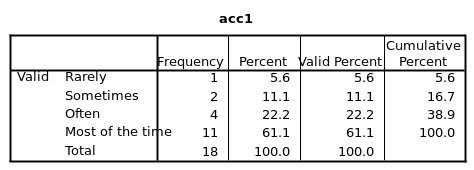
- My participation in Mahara Gives me a professional online presence as an
- EFL learner

- My participation in Mahara forum makes me focus my attention on the type of EFL Skill I most want to pursue and teach in the future
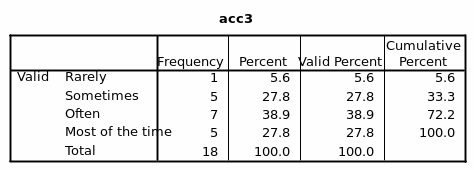
- The web site included a course syllabus, a sample of projects plan, sample course evaluation questions, a listing of teaching resources

- The course site in Mahara resolved many assessment problems, such as class participation.

- The course site in Mahara was easy to navigate and has a consistent look and feel.
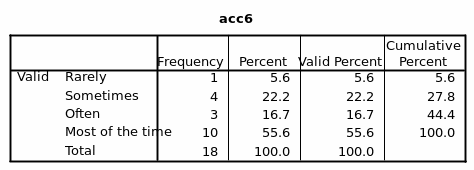
- Participating in the course forum through Mahara makes me socially motivated to please my colleagues and my instructor.

- The social participation in the course forum through Mahara makes me motivated to use my English language skills proficiently
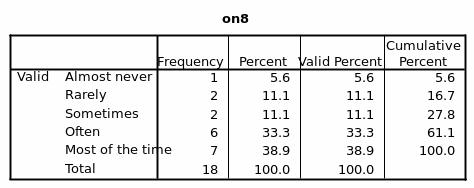
- I will continue to use my EFL teaching portfolio long after our course has been completed!
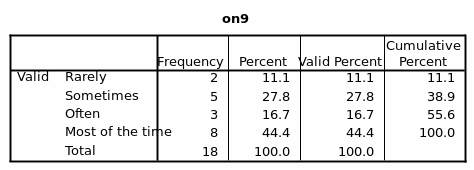
- My active contribution and involvement allows other students on the network to acknowledge my resources, contributions, and ideas — creating reciprocal relationships and shared understandings
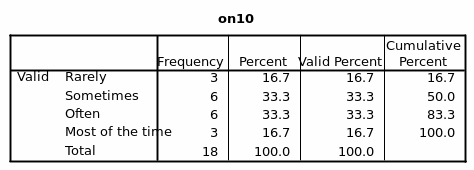
- Using the course portfolio provides a durable, portable, navigable alternative to hard-copy samples

- The course website is ideal for showing help systems, interactive content, and multimedia that enhance my English language skills
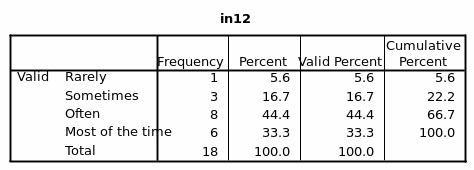
- The additional feedback that peers provide is a valuable means for enriching and informing the assessment process of my English language skills.
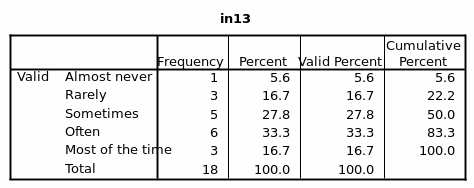
- The course website enables any number of people to review your work pertinent to TEFL simultaneously.

- The course website is a helpful way to see other works that can help generate ideas for one’s own work and construct knowledge of TEFL.

- Through participating in Mahara forum, it makes us shift from traditional EFL teaching to online language pedagogy and course design
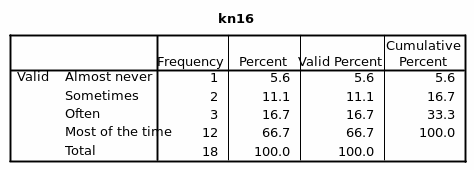
- Combining data from different sources through the course website leads to creation of new EFL teaching methodologies and techniques.

- Using the course website increased the number of active participations in an architectural way

- The course portfolio provides a “richer picture” of students, their learning and their competencies of EFL.

- I was actively involved in my processes of learning the language.
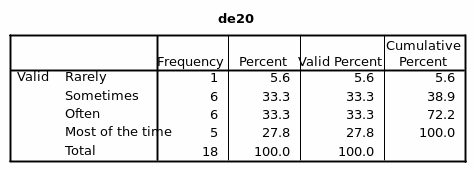
- The course Portfolio provides a means for me to learn to manage my English language development.
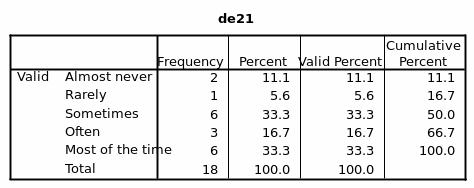
- The course Portfolio provides a means for me to learn to manage my professional development as a teacher of EFL
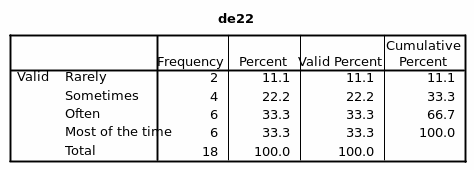
- The online portfolio assessment system of the course helped us to demonstrate our English language skills more completely, thus, achieve more successful outcomes.

Calculating weighted averages of scores to show the opinion of respondents on each concept:
- The Students’ opinion toward using the online portfolio as an easily accessible and motivating learning environment
- The Students’ opinion toward using the online portfolio as a socializing learning environment
- The Students’ opinion toward using the online portfolio as a source of information and knowledge exchange
- Students’ opinion toward using the online portfolio as a knowledge developing tool
- Students’ opinion toward using the online portfolio as a tool that fosters students’ reflective thinking and assessment
Estimating the relationships between the five statementszA16
Correlations
- * Correlation is significant at the 0.05 level (2-tailed).
- ** Correlation is significant at the 0.01 level (2-tailed).
From the correlation matrix above, we find that:
- Online socialization is correlated with information exchange (56.5%) and knowledge construction (80.3%) and development (59.3%)
- Information exchange is correlated with knowledge construction (70.1%)
- Knowledge construction is correlated with development (66.6%)
Emancipated online socialization among EFL learners through e-portfolio learning usually boosts the opportunities of information exchange. The moment individuals share the concepts they have been in class, their knowledge on certain concepts that they were not aware of is highly improved. Whenever students engage in an online academic interaction, the ability of the learner to develop new ideas is highly improved. From constructing of new ideas, the development of the learners’ knowledge is highly improved.
Recommendations
The electronic portfolio of learning in educational institutions should be highly encouraged in diverse nations. This is because the use online technologies allows for easy collection and organization of data in diverse formats. This method also allows for effortless maintenance and revision of the learning materials. The internet based portfolios are also not restricted by either time or space.
There is need to implement the e-portfolio method of learning in various states around the globe. This should be done for the purpose of creating an easily accessible and motivating learning environment to all the students to facilitate an effective learning activity. This method should also be encouraged for the purpose of creating an emancipated socializing learning environment to facilitate an effortless mastering of the tutored concepts (Ellsworth, 2002). Due to the fact that the electronic method of learning is a source of both knowledge and information exchange, implementing this method will aid in enhancing an effective learning activity.
The implementation of this method will help in boosting the level of knowledge among the EFL learners. This is because the e-portfolio is attested as a basic tool for developing knowledge among the interested. The electronic method of learning ought to be encouraged to facilitate the assessment of the learners. The EFL learners will be able to gauge themselves whether they have understood the tutored concepts or not.
Due to its positive outcomes, it is needed to implement the e-portfolio program in various learning institutions. The program usually aims at raising an independent attitude toward learning a language in the students. This program is also relevant as it helps in the incorporation of multimedia technology as an underpinning of the activities done within the classroom.
It is of great importance to note that in many EFL situations, most institutions cannot afford the resources of the multimedia technology. In addition to this, the institutions lack adequate space for installation and maintenance of multimedia centers for instance ELC. This poses a challenge to most of the language tutors. They should devise ways of improving the state of their classrooms so that their students can maximally benefit from the e-portfolio learning program.
The government should take part in the provision of income for the initiation of the required multimedia centers. This is due to the fact that most governmental policies emphasize on equal learning opportunities among EFL learners. The provision of funds to develop ELC’s will give all learners an opportunity to gain from the e-portfolio of learning.
Conclusion
In colleges of education, e-portfolios are being used as tools for assessment. Others choose to create a personal e-portfolio as a collection of their college work and reflection of their experiences. An e-portfolio can also be used in support of career planning and resume building, advising and academic planning, academic evaluation and assessment, and as a tool for self-reflection. Indeed, there are many valid reasons and practical applications for the creation of an e-portfolio—and as multimedia technology continue to evolve and more students gain access to e-portfolio software, the adoption of e-portfolios in higher education will continue to increase.
The idea behind the e-Portfolio is that students should be able to use their own tools for learning. Weigel (2002) stated that:
The e-portfolio tools that students will use will be those that are easy for them to use and that will let them use the media and communications methods that they are using in their everyday lives. The tool must motivate the student. The tool must have an interface and features that motivates the students; it must have something that makes them want to use the tool for their own enjoyment. (p. 88)
My suggestion is simple: to implement a program that seeks to raise in the student an autonomous attitude toward learning a language and the integration of multimedia technology as a reinforcement of in-classroom activities.
It is important to recognize that in many EFL situations not all schools have the resources and space to install and maintain a multimedia center like the ELC. Nevertheless, it is a challenge for language teachers to seek ways to improve our classes.
It is also important for governments of different states to chip in order to enhance effectual EFL learning methods. Since this is a global issue, the governments should help by providing funds for creation of space and initiation of multimedia centers. Through this, all EFL learners will be able to achieve the utmost benefit from the electronic based method of learning.
References
Abrami, P. & Barrett, H. (2005). Directions for Research and Development on Electronic Portfolios, Canadian Journal of Learning and Technology, 31 (3), 25-27.
Avraamidou, L. & Zembal-Saul, C. (2004). Exploring the Influence of Web-Based Portfolio Development on Learning To Teach Elementary Science. Journal of Technology and Teacher Education, 11(3), 41-42.
Barrett, H. (2000). Create your own electronic portfolio. Learning and Leading With Technology, 27(7), 1421.
Batson, T. (2002). The Electronic Portfolio Boom: What’s It All About? 16(5), 14-17.
Campbell, M. I., & Schmidt, K. J. (2005). Polaris: An undergraduate online portfolio system that encourages personal reflection and career planning. International Journal of Engineering Education, 21(5), 93-94.
Chamot, U. A., & O’Malley, M. J. (1994). The CALLA Handbook: Implementing the Cognitive Language Learning Approach. Reading, MA: Addison Wesley.
Chen, M. Y. (2005). Peer and SelfAssessment in EFL Classrooms: Selected Papers of the Fourteenth International Symposium on English Teaching. Taipei: Crane Publishing.
Dickinson, L. (1987). Self instruction in Language Learning. Cambridge: Cambridge University Press.
Ellsworth, J. (2002). Using student portfolios to increase reflective practice among elementary teachers. Journal of Teacher Education, 53(4), 52-70.
Foote, C.J., & Vermette, P.J. (2001). Teaching portfolio 101: Implementing the teaching portfolio in introductory courses. Journal of Instructional Psychology, 28(1), 31-37.
Hartnell-Young, E. & Morriss, M. (2007). Digital Portfolios: Powerful Tools for Promoting Professional Growth and Reflection, Thousand Oaks, CA: Corwin Press.
Heath, M. (2002). Electronic portfolios for reflective self assessment.Teacher Librarian , 30(1), 19-23.
Huang, H., & Hung, S. (2010). Effects of electronic portfolios on EFL oral performance.The Asian EFL Journal Quarterly , 192-212.
McIsaac, S. M., & Gunawardena, C. N. (1996). Distance Education. New York: Simon and Schuster Macmillan.
O’Malley, J. M., & Valdes, L. (1996). Authentic assessment for English language learners: Practical approaches for teachers. New York: Addison Wesley Publishing Co.
Pullman, G. (2002). Electronic portifolios revisted. the efolios project, computers and composition , 19(1),151-169.
Sherry, A., & Bartlett, A. (2005). Worth of electronic portfolios to education majors: A two by four perspective. Journal of Educational Technology Systems, 33(4), 39-49.
Wade, A., & Sclater, J. (2005). An Electronic Portfolio to Support Learning. Canadian Journal of Learning and Technology, Volume 31(3), 35-38.
Wade, R.C., & Yarbrough, D.B. (1996). Portfolios: A tool for reflective thinking in teacher education. An International Journal of Research and Studies, 12(1), 63.
Weigel, V. (2002). Deep learning for a digital age: Technology’s untapped potential to enrich higher education. San Francisco: Jossey-Bass